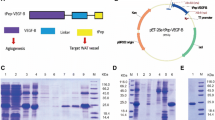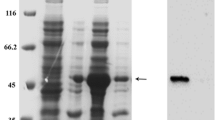Abstract
Thymosin beta 10 (TB10) is one of the common members among beta-thymosins. Human TB10 is reported to play a role in anti-angiogenesis and inhibition of cell migration during the tumorigenesis or metastasis of some certain cancers. Thus, it would be a potent clinical agent. In the present study, the coding sequence of TB10 was optimized based on the codon preference of Escherichia coli and cloned to pET28a (+) by chemical synthesis and molecular cloning methods. The recombinant protein was highly expressed employing E. coli expressing system and purified by a simple step of Ni2+ affinity chromatography. The TEV proteinase recognition site was inserted in the His6-tag and the target protein for easy removal of the His6-tag. To improve the biological activity of TB10, the transactivator of transcription (TAT) short peptide, a transduction domain, was added to the N-terminus of TB10. About 14.3 mg of the recombinant TB10 proteins was obtained from 1 L bacterial culture. The functional analyses demonstrated that the recombinant TB10 proteins displayed the distinct inhibition on angiogenesis by chick embryo chorioallantoic membrane assay and endothelial cell migration by wound healing assay. The TAT-fused TB10 even had stronger effects, probably due to the better transduction into the cells.





Similar content being viewed by others

Abbreviations
- CAM:
-
Chick chorioallantoic membrane
- E. coli :
-
Escherichia coli
- EK:
-
Enterokinase
- HUVEC:
-
Human umbilical vein endothelial cell
- HIV:
-
Human immunodeficiency virus
- Ras:
-
Rat sarcoma
- RE:
-
Restriction endonuclease
- SDS-PAGE:
-
Sodium dodecyl sulfate-polyacrylamide gel electrophoresis
- TAT:
-
Transactivator of transcription
- TB4:
-
Thymosin β4
- TB10:
-
Thymosin β10
- TEV:
-
Tobacco etch virus protease
- VEGF:
-
Vascular endothelial growth factor
References
Sribenja S, Li M, Wongkham S et al (2009) Advances in thymosin β10 research: differential expression, molecular mechanisms, and clinical implications in cancer and other conditions. Cancer Invest 27:1016–1022. https://doi.org/10.3109/07357900902849640
Erickson-Viitanen S, Ruggieri S, Natalini P, Horecker BL (1983) Thymosin beta 10, a new analog of thymosin beta 4 in mammalian tissues. Arch Biochem Biophys 225:407–413
Vassiliadou I, Leondiadis L, Ferderigos N et al (1999) Investigation of the epitopic structure of thymosin beta10 by epitope mapping experiments. Peptides 20:411–414
Hannappel E (2007) beta-Thymosins. Ann NY Acad Sci 1112:21–37. https://doi.org/10.1196/annals.1415.018
Mannherz HG, Hannappel E (2009) The β-thymosins: intracellular and extracellular activities of a versatile actin binding protein family. Cell Motil Cytoskelet 66:839–851. https://doi.org/10.1002/cm.20371
Tsitsiloni OE, Yialouris PP, Echner H et al (1992) Evidence for the extranuclear localization of thymosins in thymus. Experientia 48:398–402
Yu FX, Lin SC, Morrison-Bogorad M et al (1993) Thymosin beta 10 and thymosin beta 4 are both actin monomer sequestering proteins. J Biol Chem 268:502–509
Sribenja S, Wongkham S, Wongkham C et al (2013) Roles and mechanisms of β-thymosins in cell migration and cancer metastasis: an update. Cancer Invest 31:103–110. https://doi.org/10.3109/07357907.2012.756111
Zhang X, Ren D, Guo L et al (2017) Thymosin beta 10 is a key regulator of tumorigenesis and metastasis and a novel serum marker in breast cancer. Breast Cancer Res 19:15. https://doi.org/10.1186/s13058-016-0785-2
Zhang X-J, Su Y-R, Liu D et al (2014) Thymosin beta 10 correlates with lymph node metastases of papillary thyroid carcinoma. J Surg Res 192:487–493. https://doi.org/10.1016/j.jss.2014.05.066
Theunissen W, Fanni D, Nemolato S et al (2014) Thymosin beta 4 and thymosin beta 10 expression in hepatocellular carcinoma. Eur J Histochem 58:2242. https://doi.org/10.4081/ejh.2014.2242
Santelli G, Califano D, Chiappetta G et al (1999) Thymosin beta-10 gene overexpression is a general event in human carcinogenesis. Am J Pathol 155:799–804
Sribenja S, Sawanyawisuth K, Kraiklang R et al (2013) Suppression of thymosin β10 increases cell migration and metastasis of cholangiocarcinoma. BMC Cancer 13:430. https://doi.org/10.1186/1471-2407-13-430
Lee S-H, Zhang W, Choi J-J et al (2001) Overexpression of the thymosin β-10 gene in human ovarian cancer cells disrupts F-actin stress fiber and leads to apoptosis. Oncogene 20:6700–6706. https://doi.org/10.1038/sj.onc.1204683
Kim Y-C, Kim B-G, Lee J-H (2012) Thymosin β10 expression driven by the human TERT promoter induces ovarian cancer-specific apoptosis through ROS production. PLoS ONE 7:e35399. https://doi.org/10.1371/journal.pone.0035399
Lee S-H, Son MJ, Oh S-H et al (2005) Thymosin {beta}(10) inhibits angiogenesis and tumor growth by interfering with Ras function. Cancer Res 65:137–148
Mu H, Ohashi R, Yang H et al (2006) Thymosin β10 inhibits cell migration and capillary-like tube formation of human coronary artery endothelial cells. Cell Motil Cytoskelet 63:222–230. https://doi.org/10.1002/cm.20117
Zhang T, Li X, Yu W et al (2009) Overexpression of thymosin beta-10 inhibits VEGF mRNA expression, autocrine VEGF protein production, and tube formation in hypoxia-induced monkey choroid-retinal endothelial cells. Ophthalmic Res 41:36–43. https://doi.org/10.1159/000163220
Koutrafouri V, Leondiadis L, Avgoustakis K et al (2001) Effect of thymosin peptides on the chick chorioallantoic membrane angiogenesis model. Biochim Biophys Acta 1568:60–66
Becker-Hapak M, McAllister SS, Dowdy SF (2001) TAT-mediated protein transduction into mammalian cells. Methods 24:247–256. https://doi.org/10.1006/meth.2001.1186
Nagahara H, Vocero-Akbani AM, Snyder EL et al (1998) Transduction of full-length TAT fusion proteins into mammalian cells: TAT-p27Kip1 induces cell migration. Nat Med 4:1449–1452. https://doi.org/10.1038/4042
Fang L, Jia K-Z, Tang Y-L et al (2007) An improved strategy for high-level production of TEV protease in Escherichia coli and its purification and characterization. Protein Expr Purif 51:102–109. https://doi.org/10.1016/j.pep.2006.07.003
Grosjean H, Fiers W (1982) Preferential codon usage in prokaryotic genes: the optimal codon-anticodon interaction energy and the selective codon usage in efficiently expressed genes. Gene 18:199–209
Sun Q-M, Cao L, Fang L et al (2005) Expression, purification of human vasostatin120–180 in Escherichia coli, and its anti-angiogenic characterization. Protein Expr Purif 39:288–295. https://doi.org/10.1016/j.pep.2004.10.024
Pei G, Lan Y, Lu W et al (2018) The function of FAK/CCDC80/E-cadherin pathway in the regulation of B16F10 cell migration. Oncol Lett 16:4761–4767. https://doi.org/10.3892/ol.2018.9159
Grada A, Otero-Vinas M, Prieto-Castrillo F et al (2017) Research techniques made simple: analysis of collective cell migration using the wound healing assay. J Invest Dermatol 137:e11–e16. https://doi.org/10.1016/j.jid.2016.11.020
Rho SB, Chun T, Lee S-H et al (2004) The interaction between E-tropomodulin and thymosin beta-10 rescues tumor cells from thymosin beta-10 mediated apoptosis by restoring actin architecture. FEBS Lett 557:57–63
Li W, Song L, Wu S et al (2011) Expression, purification and characterization of a novel soluble human thymosin alpha1 concatemer exhibited a stronger stimulation on mice lymphocytes proliferation and higher anti-tumor activity. Int J Biol Sci 7:618–628
Xue X-C, Yan Z, Li W-N et al (2013) Construction, expression, and characterization of thymosin alpha 1 tandem repeats in Escherichia coli. Biomed Res Int 2013:720285. https://doi.org/10.1155/2013/720285
Wang F, Yu T, Zheng H, Lao X (2018) Thymosin Alpha1-Fc modulates the immune system and down-regulates the progression of melanoma and breast cancer with a prolonged half-life. Sci Rep 8:12351. https://doi.org/10.1038/s41598-018-30956-y
Cha H-J, Jeong M-J, Kleinman HK (2003) Role of thymosin beta 4 in tumor metastasis and angiogenesis. J Natl Cancer Inst 95:1674–1680. https://doi.org/10.1093/jnci/djg100
Malinda KM, Sidhu GS, Banaudha KK et al (1998) Thymosin alpha 1 stimulates endothelial cell migration, angiogenesis, and wound healing. J Immunol 160:1001–1006
Acknowledgements
The authors are grateful to Dr. Hua Zi-Chun for TEV and valuable suggestions. This work was supported by the Scientific Research Foundation for the Returned Overseas Chinese Scholars, State Education Ministry, the Fujian Provincial Nature Science Foundation (2015J05052), the Chinese National Nature Sciences Foundation (31501232), the FAFU Science Fund for Distinguished Young Scholars (xjq201629), the FAFU Science grant for innovation (CXZX2018119), the Education and research projects for young teachers in Fujian provincial Education Hall (JT180137), and the science & technology innovation fund of Fujian Agriculture and Forestry University (CXZX2017512, KFA17583A).
Author information
Authors and Affiliations
Corresponding author
Additional information
Publisher's Note
Springer Nature remains neutral with regard to jurisdictional claims in published maps and institutional affiliations.
Electronic supplementary material
Below is the link to the electronic supplementary material.
Rights and permissions
About this article
Cite this article
Jia, K., Lin, M., Kong, D. et al. Recombinant Expression and Bioactivity Characterization of TAT-Fused Thymosin β10. Protein J 38, 675–682 (2019). https://doi.org/10.1007/s10930-019-09855-2
Published:
Issue Date:
DOI: https://doi.org/10.1007/s10930-019-09855-2



